Posts Tagged ‘Chinese’
Friday, November 28th, 2014
This porcelain helmut-shaped cream jug, decorated in the Imari palette of blue, iron red and gilt, stands 4-1/4″ tall. It was made in China during the Qianlong period (1736-1795.) The hand painted decoration of floral sprigs and alternating blue panels suggests it was made for export to the Persian market.
At one point in its early life, the original porcelain handle snapped off, leaving it impossible to gracefully pass the cream at the dining table. It was brought to a tinker or metalsmith who fashioned this ornate replacement handle, possibly repurposed from an existing silver item. The delicate silver replacement is more ornate than the original branch-form handle, but adds just the right touch of class and whimsy.
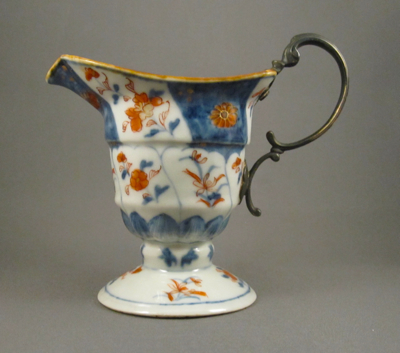
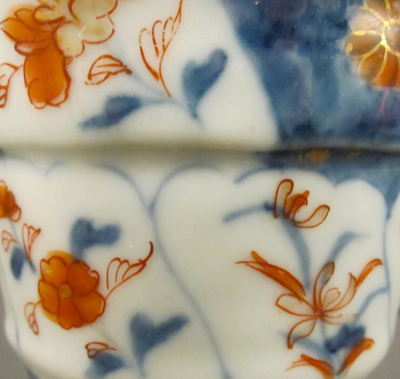
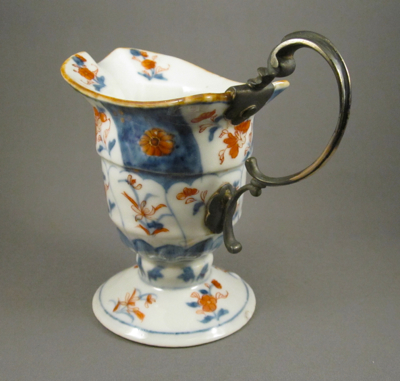
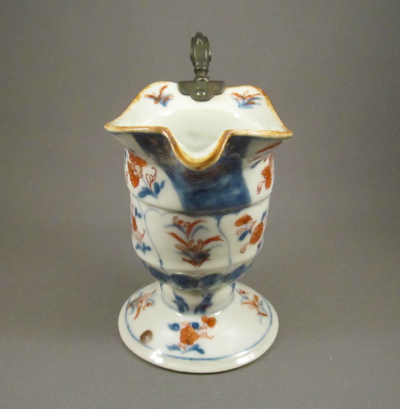
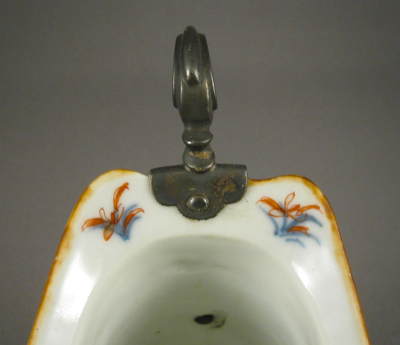
The center jug, with similar form and decoration, shows what the original handle on my jug might have looked like.
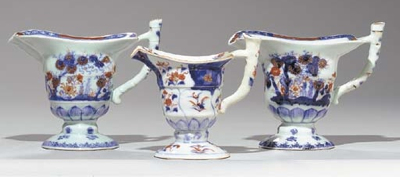
Photo courtesy of Christie’s
Tags:Chinese, Imari, metal handle, porcelain, Qianlong
Posted in jug | 3 Comments »
Sunday, November 16th, 2014
This delicate porcelain teapot was made in China for export to Europe during the Qianlong reign (1711-1799.) It is decorated “en grisaille”, a pencil style drawing in black, with touches of overglaze enamel of iron red and gilt. The European subject depicts a lady in her boudoir daintily clipping her toe nails as a male attendant watches nearby. This must have been a racy subject for the Chinese porcelain painters, raising more than a few eyebrows in the studio. Decoration of this kind was typically based on current popular engravings, reinterpreted by Chinese painters with sometimes amusing results.
When this 3-3/8″ high teapot dropped and broke in half, a china mender stapled it back together. I like how the bold metal staples and the darkened cracks add another layer of pattern to the decoration. The lid, possibly broken at the same time that the pot was damaged, has since gone missing. I am hoping to make a tin replacement cover for it one day.
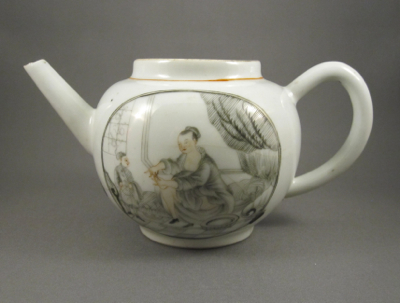

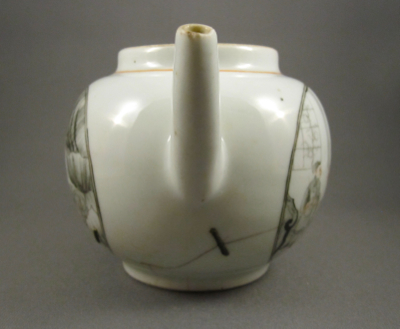
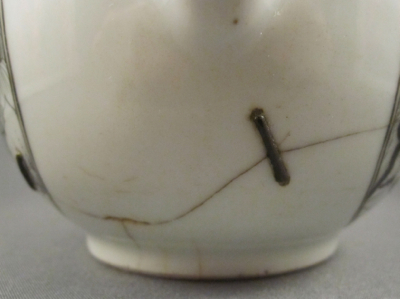

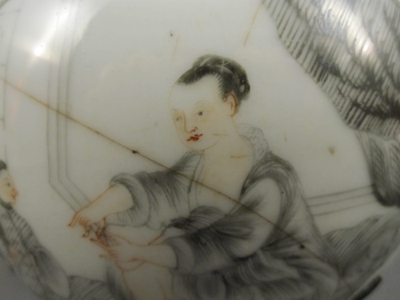
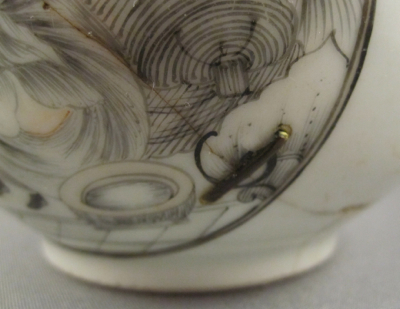
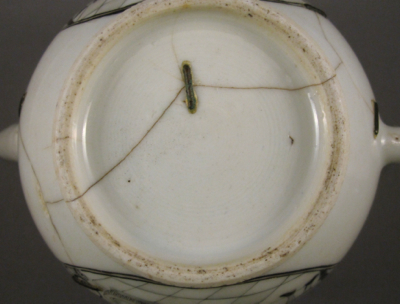
Tags:Chinese, porcelain, staples/rivets
Posted in teapot | 2 Comments »
Saturday, September 27th, 2014
This sturdy Chinese export porcelain mug dates from the Qianlong period (1736-1795) and has floral decoration and a pseudo armorial cipher/monogram hand painted in the famille rose palette. The mug stands 6-1/2″ high and holds 2 pints of liquid. I am surprised that the entwined handle survived 230 years of use, as they are fragile and are often found broken.
Now, you may wonder “where’s the repair?” The unsigned sterling silver mount along the top with engraved decoration serves a dual purpose. It stabilizes a long vertical crack running the entire length and most likely masks chips along the rim. A beautiful solution which further enhances an already lovely piece.
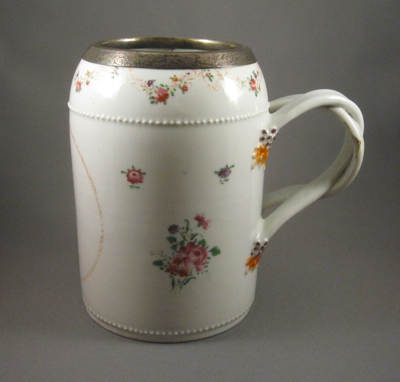
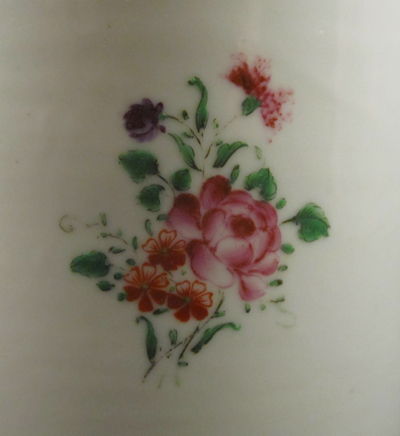
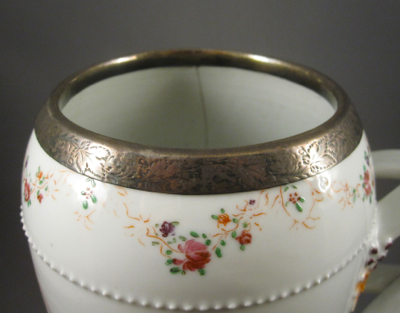
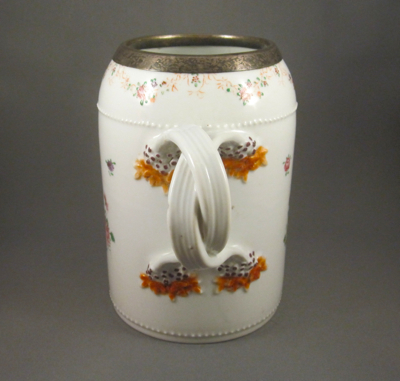
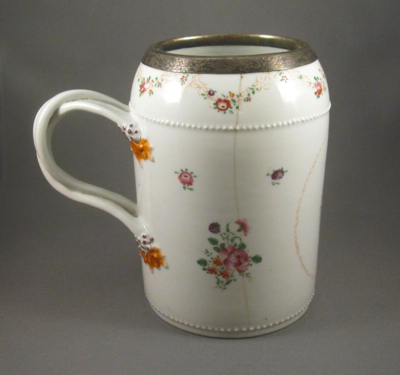
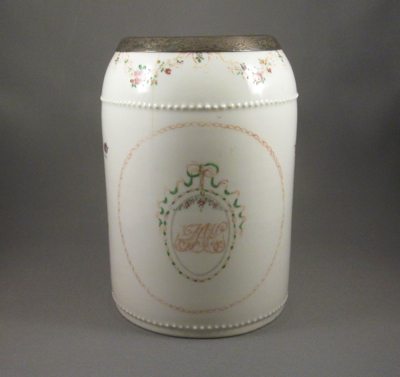
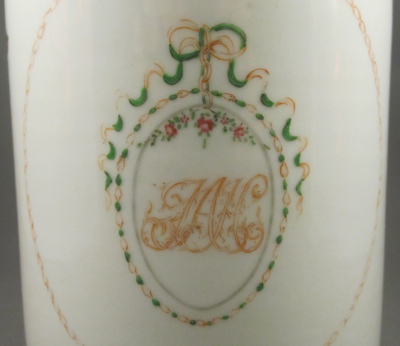
This mug is almost identical in form and decoration but does not have the silver rim that mine has.
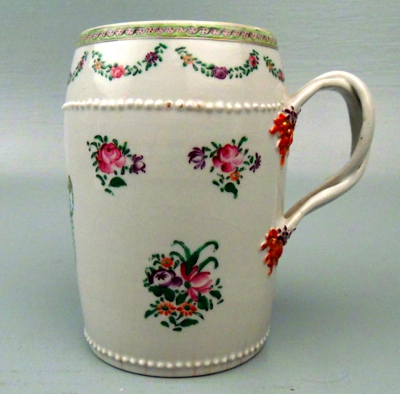
Photo courtesy of eBay
Tags:Chinese, porcelain, silver
Posted in mug/tankard | 2 Comments »
Saturday, September 13th, 2014
This Qianlong period globular form teapot has a C shaped handle and an inlaid flat lid with round knob. It was made in China in the mid-1700s and stands 4-1/4″ tall and 7-3/4″ from handle to spout. The original blue underglaze decoration fell out of fashion shortly after it was made, as by the mid-1700s more “attractive colors” were the taste of the day. In order to keep up with the sudden demand for polychrome Chinese ceramics, factories in Europe took the unwanted blue and white decorated pieces and overpainted them with brightly colored enamels, often without regard for the original design beneath. This victim of clobbering, as it is also referred to, or Amsterdam Bont, when done in Holland, has been over decorated with the flower basket motif, one of the most popular designs.
The unusual form replacement silver spout appears to have been made by a skilled 18th century silversmith. It replaced a straight spout, but I think this replacement is much more interesting, and adds to the quirkiness of this twice-decorated teapot.
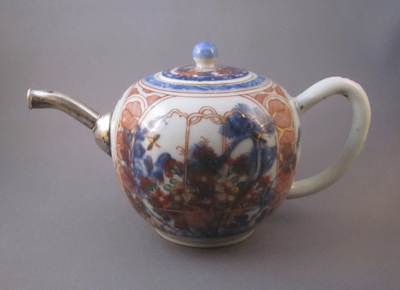


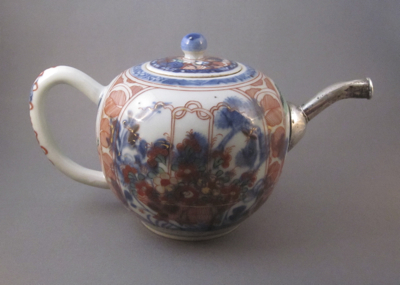
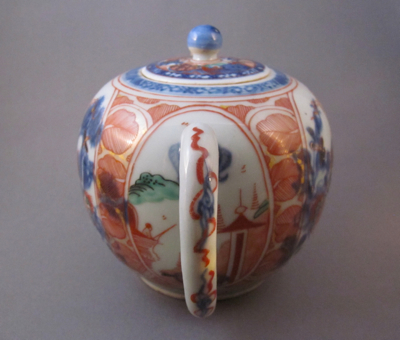
This teapot with similar form and decoration shows what the spout on my teapot might have looked like.
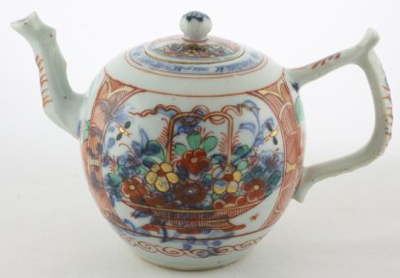
Photo courtesy of Pater Gratia Oriental Art
Tags:Chinese, clobbered, globular, metal spout, porcelain, Qianlong, silver
Posted in teapot | 1 Comment »
Sunday, September 7th, 2014
This colorful Chinese porcelain London shape tea cup dates from 1820-1850 and is decorated in the Canton rose palette. It measures 2-1/2″ high and has an opening diameter of 3-1/4″ . The outer polychrome enamel Mandarin decoration depicts a scene of scholars in a garden, and the inside of the rim has a deep painted border of dragons with small stylized clouds. This cup was originally a part of a large dinner service, custom ordered by most likely a wealthy English family.
At some point in the early life of the cup, the original porcelain handle snapped off. But rather than simply toss out the damaged goods as we would today, it was brought to a metalsmith, who fashioned a bronze replacement handle in the same form as the original. To me, the dark color and sculptural quality of the replacement handle makes this embellished cup much more interesting than its “perfect” counterpart.
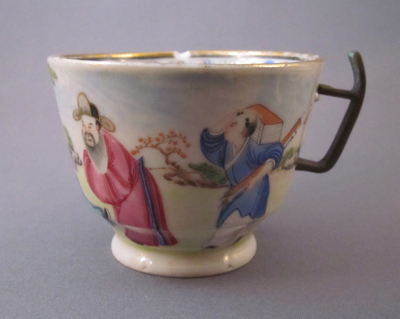
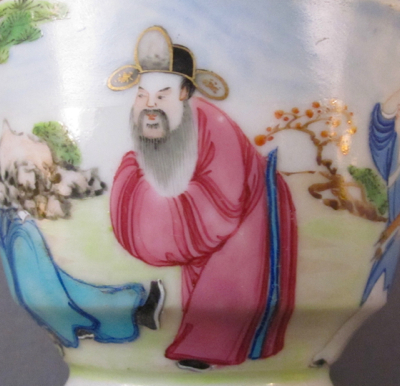
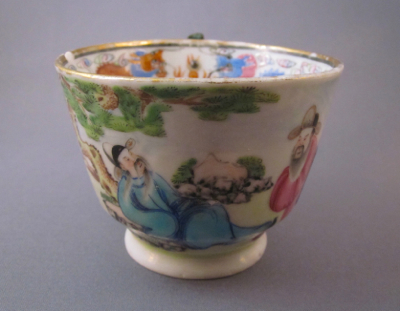
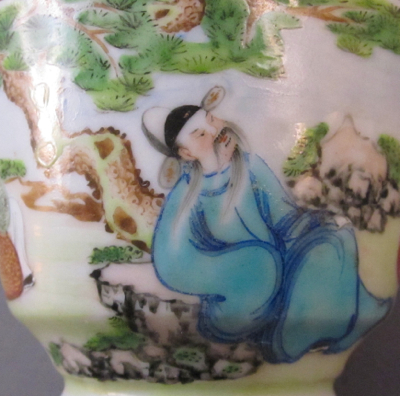
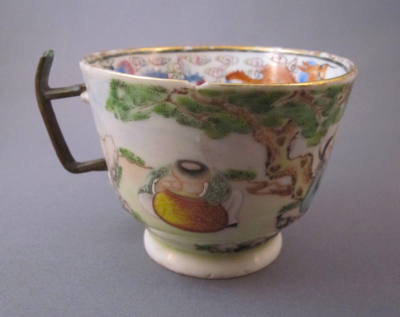


This tea cup still has its original handle intact.
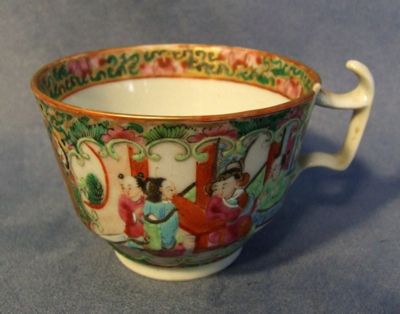
Photo courtesy of Hundred & One Antiques
Tags:Chinese, Mandarin, metal handle, porcelain
Posted in cup/saucer | 3 Comments »
Saturday, August 9th, 2014
This large globular form porcelain teapot was made in China during the middle of the 18th century and has not one but two 19th century inventive repairs. It measures 6″ high and 9-1/2″ wide from handle to spout. Both sides have the same Mandarin decoration in the famille rose palette, depicting a family scene in a garden with trees and distant mountains.
But what makes this piece so special is the unusual shaped silver replacement spout with a heart shaped back plate and the overscaled wood replacement handle in silver mounts. I imagine the wood handle was intended for a larger teapot, but it might have been the only option available at the time of repair. I found this teapot in the UK and I have seen the same replacement spout on another teapot of the same period, also in the UK. Although most antiques collectors would rather have an example of this teapot in “perfect” condition, I much prefer the whimsy and uniqueness of this survivor with its quirky embellishments.
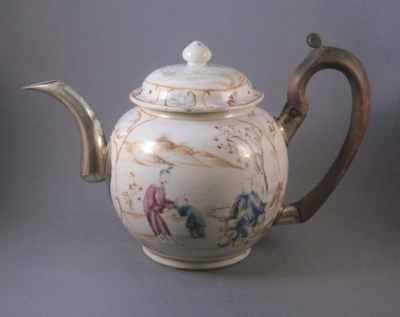
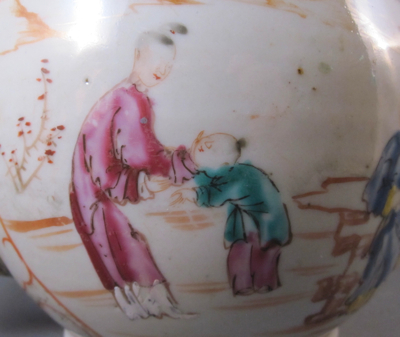

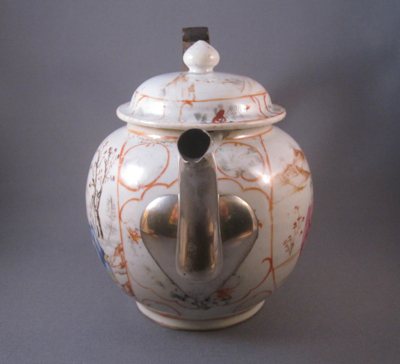
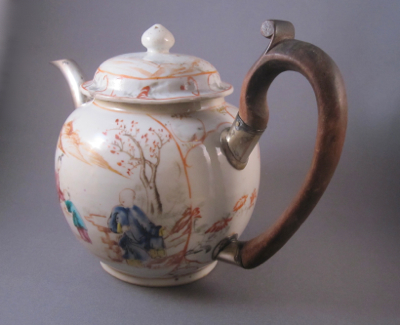
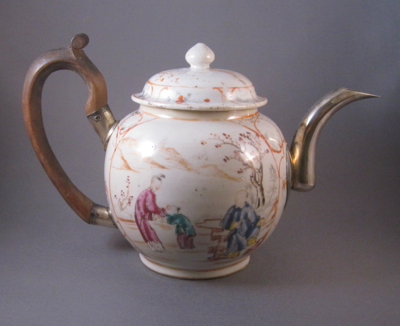
This teapot of similar form and decoration suggests what the original handle and spout on my teapot might have looked like.
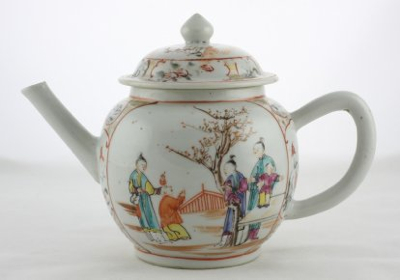
Photo courtesy of Pater Gratia Oriental Art
Tags:Chinese, Mandarin, metal spout, silver, wood handle
Posted in teapot | 8 Comments »
Sunday, August 3rd, 2014
This Chinese baluster shaped porcelain jug, with molded spout in the manner of European silver, has hand painted underglaze cobalt blue Nanking decoration of houses, trees and birds. It dates from the middle of the 18th century and stands nearly 8″ tall.
Over 100 years ago when the original reeded strap handle broke off, an unusual split form metal replacement handle was added. A clever tinker reinterpreted the original handle design by forging a bronze loop handle into four extensions and adding small discs, which were riveted to the leaf terminals. The remains of an intricately woven rattan sheath are found on about one third of the handle. Most curiously, there is an engraved signature on the underside, difficult to decipher, which may be the name of the china mender or of a previous owner. If anyone knows more about this marking, please let me know.
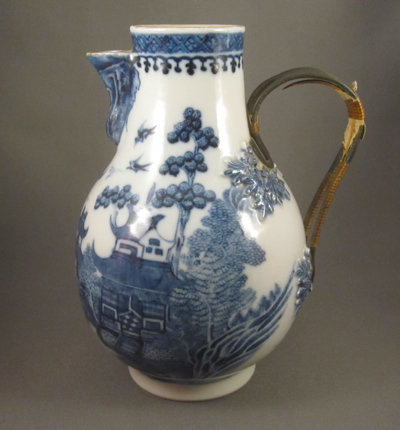
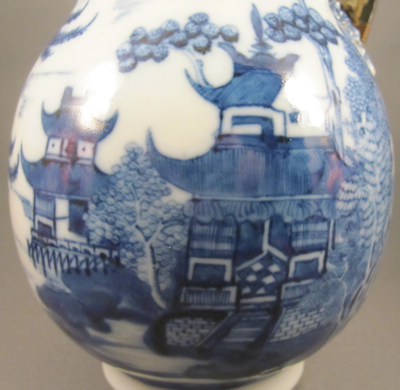
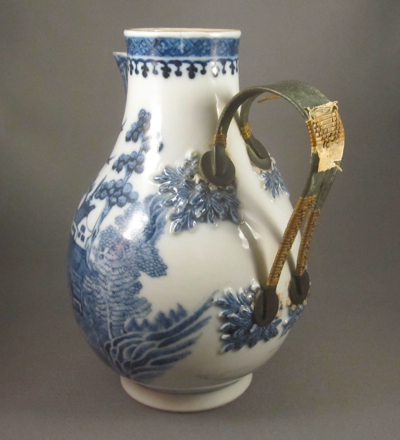

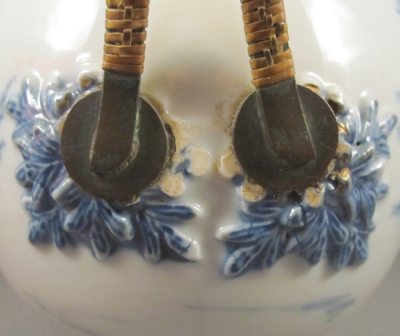
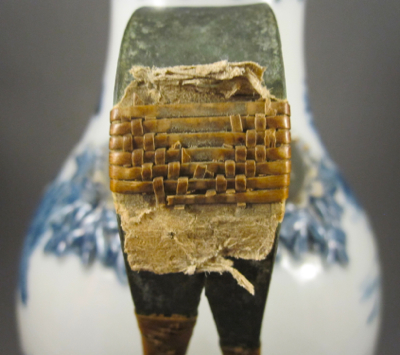

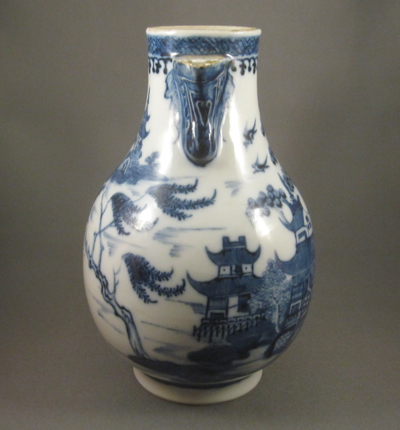
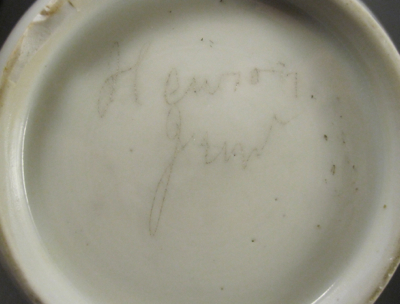
This jug with similar form and decoration shows what the original handle on my jug may have looked like.
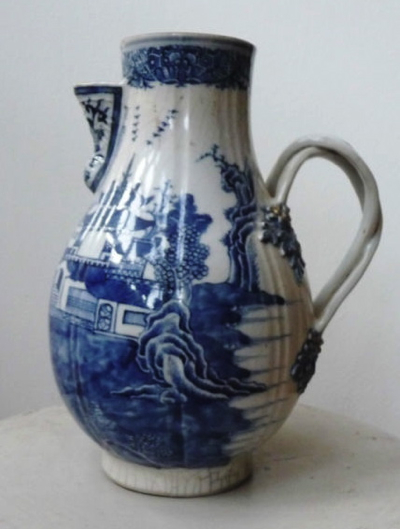
Photo courtesy of eBay
Tags:blue & white, bronze, Chinese, metal handle, porcelain, rattan
Posted in jug | 2 Comments »
Saturday, July 5th, 2014
In honor of Independence Day I am pleased to share with you a Chinese porcelain mug with a fireworks theme, made for export to North America and Europe during the Qianlong period (1736-1795). It stands 4-3/4″ high and is decorated in the Mandarin style with cloud-shaped cartouches executed in famille rose enamels, and containing floral sprigs and a family tableau depicting a child lighting fireworks.
I wouldn’t be surprised if during the first organized 4th of July celebration in 1777, a raucous party involving the lighting of fireworks forced this mug to fly off a table and crash to the ground, causing its handle to shatter and the bottom to fall off. Rather than throw out the expensive and cherished mug, it was brought to a local tinker who fashioned a sturdy brass replacement handle. To help insulate the handle from its hot contents, it was wrapped in decoratively woven rattan. The bottom was reattached to the body using five large brass staples with a bond so tight it could hold liquid without leaking. As china menders typically did not sign their work, there is no way to know who was responsible for this repair, but I imagine they each had their own signature style in weaving the rattan so that they could distinguish their work from each other.
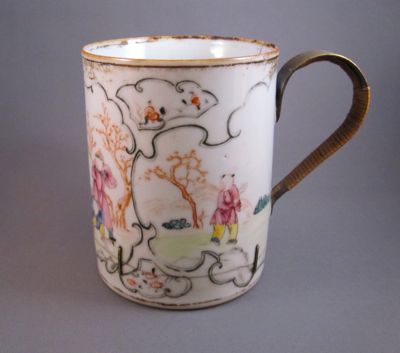
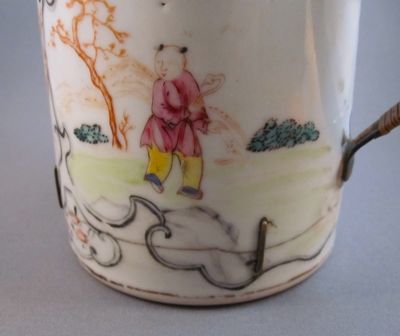
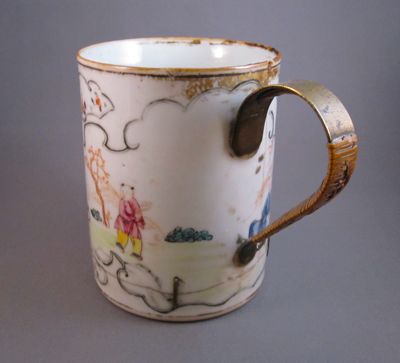

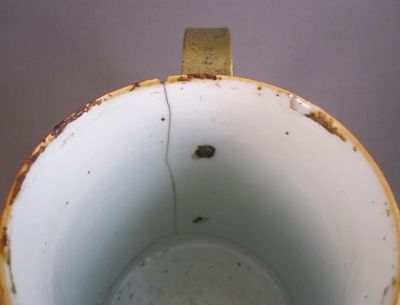

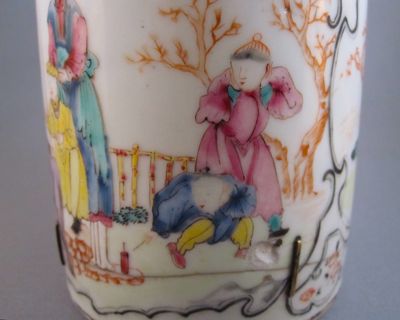
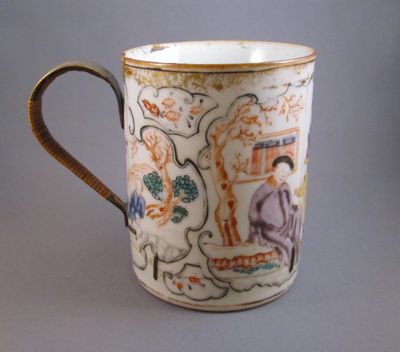

These mugs of similar form show what the original handle on my mug might have looked like.
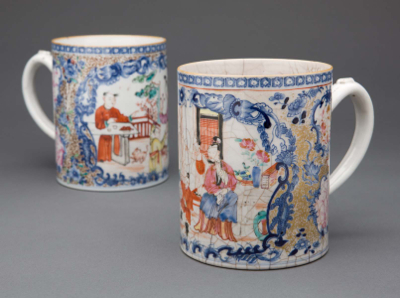
Photo courtesy of Mount Vernon’s Mystery Midden
Tags:Chinese, metal handle, porcelain, rattan, staples/rivets
Posted in mug/tankard | 5 Comments »
Sunday, June 29th, 2014
This wee globular form teapot was made in China during the Kangxi period (1661 – 1722) and measures just 2-1/2″ high and 4-1/4″ from handle to spout. It has Famille Vert decoration of floral bouquets tied with ribbon in blue underglaze enamel, iron red and green washes, and gilt highlights. The domed cover, decorated with plum blossoms, has a tiny vent hole, just as its full-size counterpart would have. I believe that this was part of a larger tea set purchased for a child from a wealthy family, as only the upper class were able to afford imported Chinese porcelain.
Without seeing the coin to show the lilliputian size of the teapot, I doubt you would have guessed that this is a miniature. The exquisitely crafted metal replacement spout and rattan-covered bronze handle are superior to the more standard repairs seen on most other miniatures. It seems that someone truly appreciated the stellar repair work, as is evident by the teeth marks at the end of the spout. Perhaps this was just a child’s way of saying “This new spout tastes better than the old one. Thanks, and job well done!”
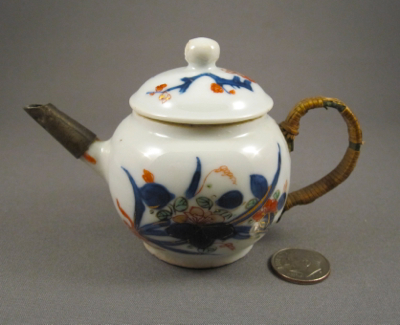
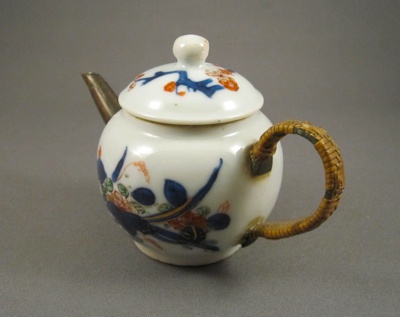
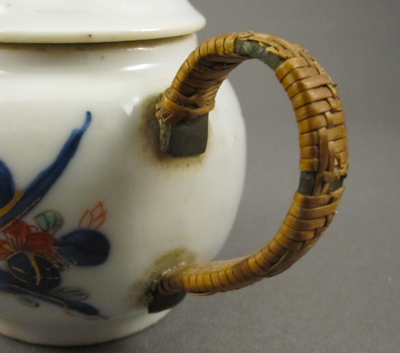
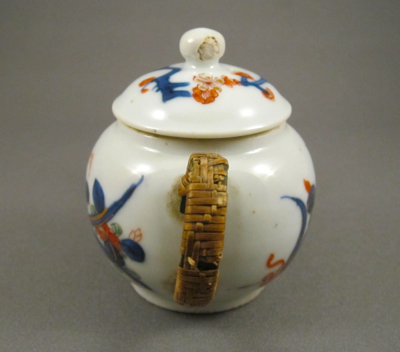
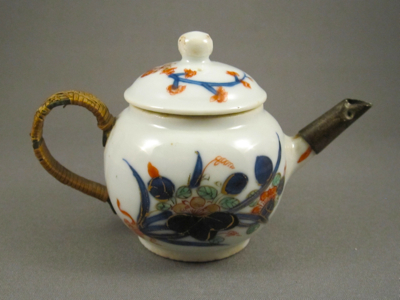
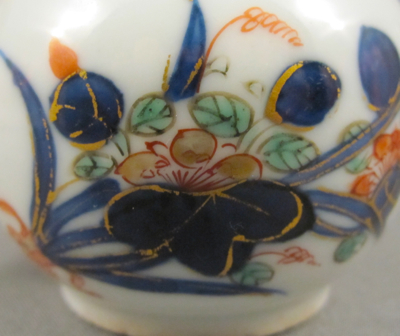
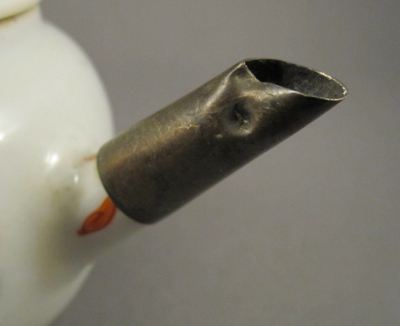
This nearly identical miniature still has its original handle and spout, but I think my teapot is the more interesting one of the pair.
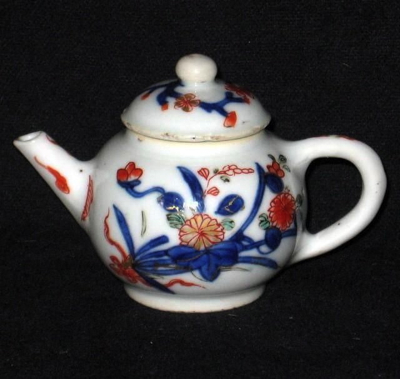
Photo courtesy of eBay
Tags:Chinese, metal handle, metal spout, miniature, rattan, silver
Posted in teapot | 3 Comments »
Saturday, June 7th, 2014
I purchased this little teapot thinking it was an example of Chinese Yixing ware with an elaborate early repair. It measures 7-1/2″ from spout to handle and is about 4″ high to top of finial. The shape appears to be typically Yixing but the brass lid, spout and horizontal strap, as well as the unusual incised mark on the underside, made me a bit suspicious. Now I feel the teapot dates from the latter part of the 19th century and was made in China for export to the Middle East, and that the mark on the base is Arabic. The brass spout and lid were most likely a part of the original design to help prolong the life of the teapot and not added to replace broken or missing parts. Learning to know the difference between a piece with an inventive repair and a piece that was designed with metal mounts can be a valuable, though sometimes a costly, lesson. Luckily, I did not pay very much for this “not-a-make-do” teapot.
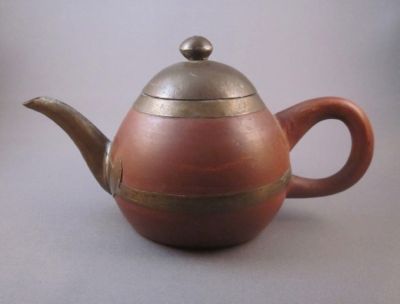



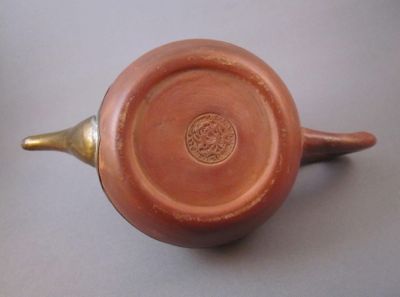

Tags:brass, Chinese, metal lid, metal spout, pottery, Yixing
Posted in teapot | 5 Comments »












































































